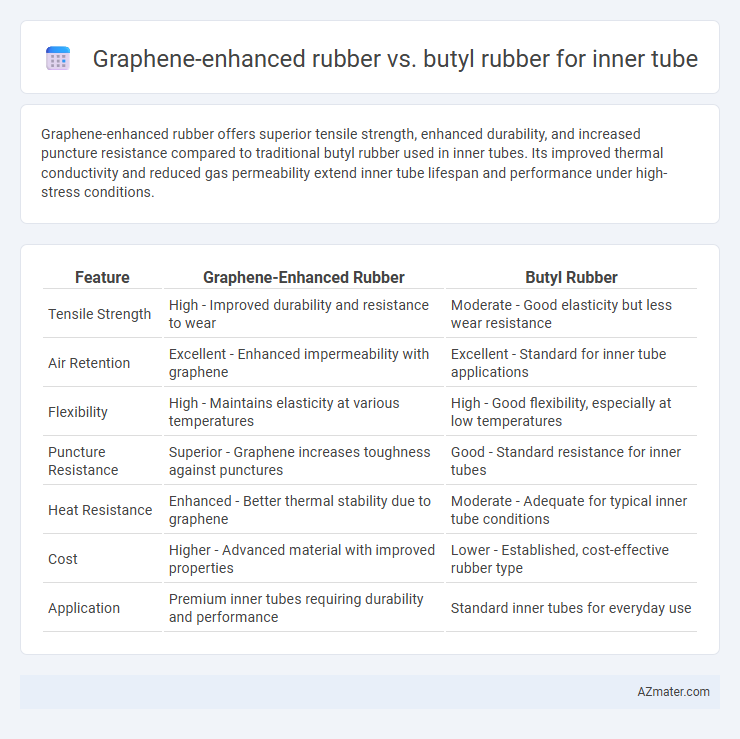Graphene-enhanced rubber offers superior tensile strength, enhanced durability, and increased puncture resistance compared to traditional butyl rubber used in inner tubes. Its improved thermal conductivity and reduced gas permeability extend inner tube lifespan and performance under high-stress conditions.
Table of Comparison
| Feature | Graphene-Enhanced Rubber | Butyl Rubber |
|---|---|---|
| Tensile Strength | High - Improved durability and resistance to wear | Moderate - Good elasticity but less wear resistance |
| Air Retention | Excellent - Enhanced impermeability with graphene | Excellent - Standard for inner tube applications |
| Flexibility | High - Maintains elasticity at various temperatures | High - Good flexibility, especially at low temperatures |
| Puncture Resistance | Superior - Graphene increases toughness against punctures | Good - Standard resistance for inner tubes |
| Heat Resistance | Enhanced - Better thermal stability due to graphene | Moderate - Adequate for typical inner tube conditions |
| Cost | Higher - Advanced material with improved properties | Lower - Established, cost-effective rubber type |
| Application | Premium inner tubes requiring durability and performance | Standard inner tubes for everyday use |
Introduction to Inner Tube Materials
Inner tube materials significantly impact tire performance, with butyl rubber and graphene-enhanced rubber being prominent options. Butyl rubber offers excellent air retention and durability due to its low permeability and chemical resistance. Graphene-enhanced rubber introduces superior mechanical strength, improved puncture resistance, and enhanced thermal conductivity, providing advanced performance benefits over traditional butyl rubber in inner tube applications.
What is Graphene-Enhanced Rubber?
Graphene-enhanced rubber is a composite material that integrates graphene nanosheets into traditional rubber matrices, significantly improving mechanical strength, elasticity, and durability. Compared to butyl rubber, which is widely used for inner tubes due to its excellent air retention and chemical resistance, graphene-enhanced rubber offers superior puncture resistance and thermal conductivity. These properties make graphene-enhanced rubber a promising alternative for inner tubes, providing enhanced performance under harsh conditions and extended lifespan.
Understanding Butyl Rubber
Butyl rubber, a synthetic rubber derived from isobutylene with minor isoprene content, is renowned for its exceptional air impermeability and resistance to heat, chemicals, and aging, making it ideal for inner tube applications. Its molecular structure provides low gas permeability, which ensures longer tire pressure retention compared to natural rubber variants. However, graphene-enhanced rubber introduces improved mechanical strength and thermal conductivity, potentially surpassing traditional butyl rubber in durability and performance while maintaining airtight properties.
Key Properties Comparison: Graphene-Enhanced vs Butyl Rubber
Graphene-enhanced rubber offers superior tensile strength, improved puncture resistance, and enhanced thermal conductivity compared to traditional butyl rubber used in inner tubes. Butyl rubber is valued for its excellent air retention, chemical resistance, and flexibility, but it lacks the mechanical reinforcement and durability brought by graphene additives. Incorporating graphene significantly extends the inner tube's lifespan and performance under high stress conditions, making it a more advanced material choice for demanding applications.
Durability and Puncture Resistance
Graphene-enhanced rubber significantly improves the durability and puncture resistance of inner tubes compared to traditional butyl rubber by reinforcing the rubber matrix with graphene's exceptional tensile strength and flexibility. This enhancement results in inner tubes that resist wear and tear more effectively, reducing the likelihood of punctures from sharp objects and extending overall lifespan. Butyl rubber, while known for good air retention and chemical resistance, lacks the advanced reinforcement properties provided by graphene, making it less resilient under harsh conditions.
Air Retention Capabilities
Graphene-enhanced rubber exhibits superior air retention capabilities compared to traditional butyl rubber for inner tubes due to its exceptional impermeability and enhanced molecular structure, which significantly reduces gas permeability. The incorporation of graphene creates a dense barrier, improving durability and minimizing air leakage over extended periods. This innovation results in longer-lasting inner tubes with reduced maintenance and improved performance under varying pressure conditions.
Weight and Flexibility Differences
Graphene-enhanced rubber significantly reduces the weight of inner tubes compared to traditional butyl rubber, delivering a lighter and more energy-efficient ride. The incorporation of graphene also improves flexibility by enhancing the material's tensile strength and elasticity, allowing better adaptability to road irregularities and reducing the risk of punctures. Butyl rubber remains heavier and less flexible, with limited stretchability and slower response to deformation under pressure, impacting overall performance.
Performance in Various Riding Conditions
Graphene-enhanced rubber inner tubes offer superior puncture resistance and enhanced flexibility compared to traditional butyl rubber, making them ideal for variable terrain and extreme riding conditions. The exceptional tensile strength and thermal conductivity of graphene composites improve durability and heat dissipation during high-speed rides, reducing the risk of blowouts. Butyl rubber inner tubes, while cost-effective and good at air retention, tend to perform less reliably under harsh conditions due to lower abrasion resistance and slower heat dissipation.
Cost and Availability
Graphene-enhanced rubber typically incurs higher production costs due to the advanced manufacturing process and the premium price of graphene additives, making it less cost-effective than butyl rubber for inner tubes. Butyl rubber remains widely available and economically preferred, benefiting from established supply chains and large-scale production. The scarcity and higher cost of graphene materials limit the widespread adoption of graphene-enhanced rubber despite its superior performance characteristics.
Conclusion: Choosing the Right Inner Tube Material
Graphene-enhanced rubber offers superior strength, puncture resistance, and improved durability compared to traditional butyl rubber, making it ideal for high-performance inner tubes. Butyl rubber remains cost-effective with excellent air retention properties, suitable for everyday use and budget-conscious consumers. The choice between graphene-enhanced and butyl rubber inner tubes depends on prioritizing enhanced performance and longevity versus affordability and reliable air impermeability.

Infographic: Graphene-enhanced rubber vs Butyl rubber for Inner tube
 azmater.com
azmater.com